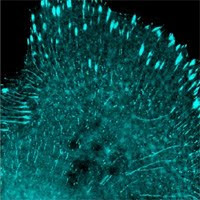How long a protein remains in cell and at what equilibrium level depends on several factors: 1) how fast it is translated; 2) how fast it is degraded; 3) how much dilution by cell division affects its balance. A good method for tracking protein degradation requires live cell measurement methods that show high resolution because the changes may be small and gradual; and that do not interfere with cellular processes. One simple method was recently described in Science by Eden et al. that relies on bleaching fluorescent protein (FP) tagged to cellular protein of interest.
To track protein half-life, only a small fraction of FP is bleached with a pulse of light that would irreversibly damage the chromophore of the FP. This treatment, called bleach chase, would produce a population of proteins that are non-fluorescent and cannot be replenished. By comparing the fluorescence of this population and the control, unbleached population, it is possible to determine the half-life of the fused proteins using equation T1/2=ln(2)/a, where a is the slope of decay of the difference between bleached and unbleached protein fluorescence on a semilogarithmic plot. (This part is recited from AlleleNews)
Conversely, instead of photobleaching a FP to create a protein population, a fluorescent signal can be created and chased by photoactivating a photoactivable FP that is fused to a cellular protein under study. Plachta et al. published in a recent issue of Nature Cell Biology that by following the half-life, or kinetics of pluripotency-related transcription factor Oct4, cell fates are predicted in early embryo development.
In fact, there is a third method, perhaps soon to be published, that a photoconvertible FP can be used for tracking fusion protein half life. By using a photoconvertible FP, such as mClavGR (already offered by Allele), a fluorescent protein population can be created as in the aforementioned studies; but unlike bleaching or photoactivating, photoconversion keeps both populations (converted and unconverted, green or red in the case of mClavGR) present. This way all readings can be internally controlled to compensate for factors not directly related to protein metabolism per se, such as cell death, equipment variation, etc.
New Product of the Week 0201411-022111: Relaunch of Orbigen Apoptosis polyclonal antibodies on the new Allele online shopping system
Promotion of the week 021311-022111: This week save 10% on all custom viral services.




No comments:
Post a Comment